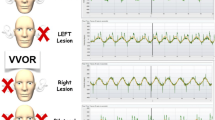Summary
Eye movements in five patients with chronic bilateral labyrinthine loss were tested with sinusoidal movements during cervico-ocular stimulation and active head movements (0.05, 0.1 and 0.2 s−1; 20, 40, and 60°) and were compared with healthy subjects. Consideration was given to saccadic activity and slow phase velocity of nystagmus and overall gaze shift. The cervico-ocular response was not altered in the patients. During active pendular head movements the saccadic activity and slow phase velocity of nystagmus were more reduced than the eye shifts. The phase relation of eye shifts was not changed. In our patients neck to eye responses did not compensate for the abolished vestibulo-ocular reflex.
Similar content being viewed by others
References
Anastasopoulos D, Mergner T (1982) Canal neck interaction in vestibular nuclear neurons of the cat. Exp Brain Res 46:269–280
Atkin A, Bender MB (1968) Ocular stabilization during oscillatory head movements. Arch Neurol 19:559–566
Barnes GR (1979) Head-eye coordination in normals and in patients with vestibular disorders. Adv Otorhinolaryngol 35:197–201
Barnes GR, Forbat LN (1979) Cervical and vestibular afferent control of oculomotor response in man. Acta Otolaryngol 88:79–87
Barlow D, Freedman W (1980) Cervico-ocular reflex in the normal adult. Acta Otolaryngol 487–496
Collewijn H (1981) The oculomotor system of the rabbit and its plasticity. In: Barlow HB (ed) Studies of brain function. Springer, Berlin Heidelberg NewYork
Dichgans J, Bizzi E, Morasso P, Tagliasco V (1973) Mechanisms underlying recovery of eye-head coordination following bilateral labyrinthectomy in monkeys. Exp Brain Res 18:548–562
Doerr M, Leopold HC, Thoden U (1981) Vestibulo-ocular reflex (VOR), cervico-ocular reflex (COR) and its interaction in active head movements. Arch Psychiatr Nervenkr 230:117–127
Doerr M, Leopold HC, Thoden U (1982) Cervically induced illusion of head movement influences cervico-ocular reflex (COR). Pflügers Arch 392:R51
Frenzel H (1928) Rucknystagmus als Halsreflex und Schlagfeldverlagerung des labyrinthären Drehnystagmus durch Halsreflexe. Z Hals-, Nasen-, Ohrenh 21:177–187
Gresty MA, Hess K, Leech J (1977) Disorders of the vestibulo-ocular reflex producing oscillopsia and mechanisms compensating for loss of labyrinthine function. Brain 100:693–716
Hikosaka O, Maeda M (1973) Cervical effects on abducens motoneurons and their interaction with vestibulo-ocular reflex. Exp Brain Res 18:512–530
Kasai T, Zee DS (1978) Eye-head coordination in labyrinthine-defective human beings. Brain Res 144:123–141
Kasper J, Thoden U (1981) Effects of natural neck afferent stimulation on vestibulo-spinal neurons in the decerebrate cat. Exp Brain Res 44:401–408
Leopold HC, Doerr M, Oepen G, Thoden U (1982) The effect of cervical and vestibular reflexes on eye movements in Huntington's Chorea. Arch Psychiatr Nervenkr 231:227–234
Meiry JL (1971) Vestibular and proprioceptive stabilization of eye movements. In: Bach-y-Rita P, Collins C, Hyde JE (eds) The control of eye movements. Academic Press, New York London, pp 483–496
Takahashi M, Uemura T, Fujishiro T (1981) Compensatory eye movement and gaze fixation during active head rotation in patients with labyrinthine disorders. Ann Otol Rhinol Laryngol 90:240–245
Takemori S, Suzuki JI (1971) Eye deviations from neck torsion in humans. Ann Otol 80:439–444
Thoden U, Doerr M, Leopold HC (1983) Motion perception of head or trunk modulates cervico-ocular reflex (COR). Acta Otolaryngol 96:9–14
Uemura T, Arai Y, Shimazaki C (1981) Disturbance of eye-head coordination during lateral gaze in labyrinthine disease. In: Cohen B (ed) Vestibular and oculomotor physiology. International Meeting of the Bárány Society. Annals of the New York Academy of Science 374:571–598
Zee DS, Yee RD, Robinson DA (1976) Optokinetic responses in labyrinthine-defective human beings. Brain Res 113:423–428
Author information
Authors and Affiliations
Additional information
Supported by the Sonderforschungsbereich “Hirnforschung und Sinnesphysiologie” (SFB 70) of the Deutsche Forschungsgemeinschaft
Rights and permissions
About this article
Cite this article
Leopold, H.C., Doerr, M. & Thoden, U. Cervico-ocular responses (COR) during slow sinusoidal head movements in subjects with bilateral labyrinthine lesions. Arch Psychiatr Nervenkr 233, 439–447 (1983). https://doi.org/10.1007/BF00342784
Received:
Issue Date:
DOI: https://doi.org/10.1007/BF00342784




